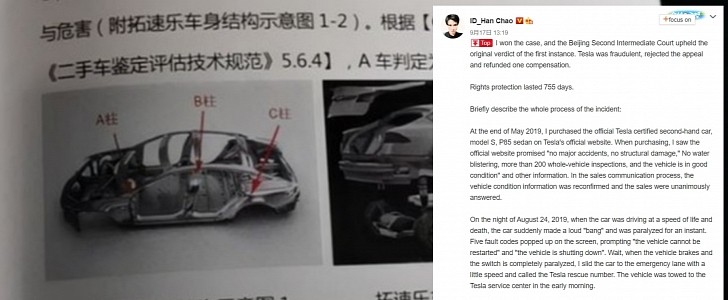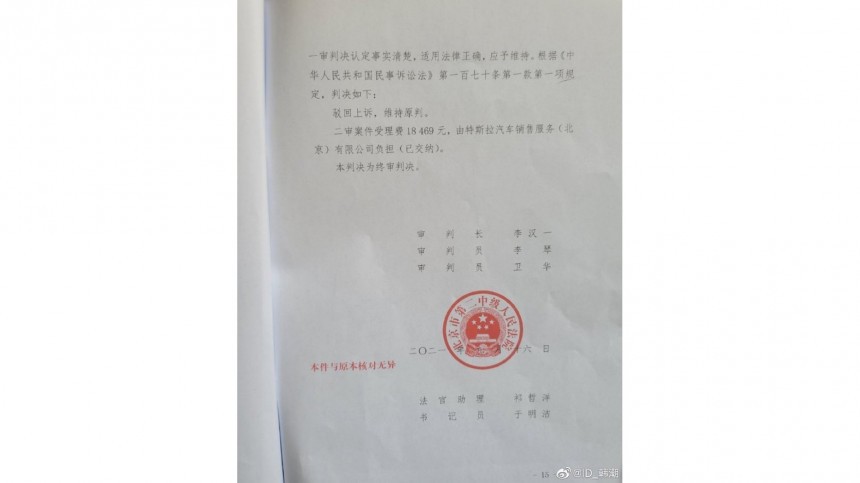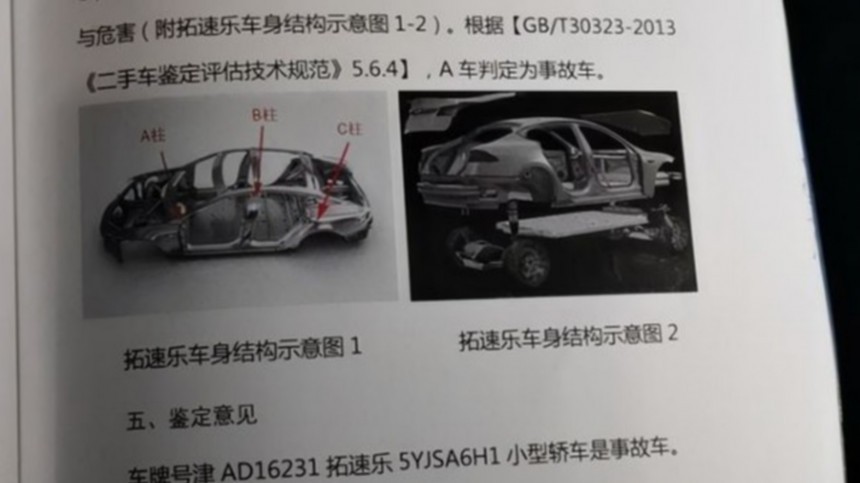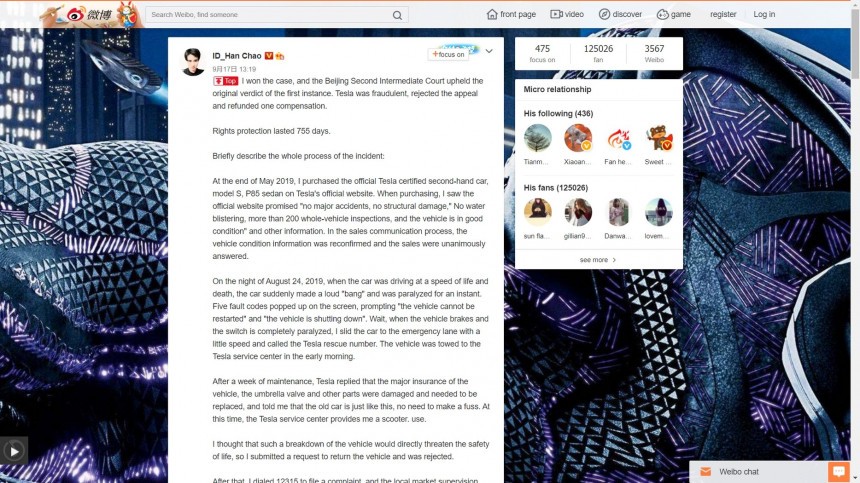Before Han Chao bought his certified used Model S P85 by the end of May 2019, Tesla told him it was never involved in any crashes and that it was approved in 200 tests. Despite that, the Chinese customer had so many issues with the vehicle that he decided to have it inspected. The car had been in a wreck and got its C-pillar replaced. After suing Tesla, Chinese justice granted Chao his money back, plus three times that value as compensation. Tesla owes him RMB1,518,800 ($235,248) for fraud, and this is the final decision.
Chao’s situation deserves a more detailed description. On June 5, right after he picked up the car, he had to take it to the Tianjin Tesla Service Center for repairs. He did that five more times until his car stopped working at 120 kph (75 mph) on a road. Chao said he heard a loud noise, five fault codes appeared on the dashboard, and the accelerator pedal died. Luckily, he managed to take the car to the roadside without causing a crash.
At this point, Chao thought the car was dangerous and tried to get his money back in a friendly way. He first asked Tesla for a refund. After he was denied, Chao contacted the Market Supervision and Administration Bureau to mediate the negotiation. Thanks to the consumer agency’s suggestion, he took his car to Wanfeng Motor Vehicle Appraisal on November 15, 2019. The company determined that his car had had its original left C-pillar and left rear fender cut and replaced. Contrary to what Tesla told him, that meant that the vehicle had crashed before.
The Chinese customer had to fix the car three other times after the road incident, bringing the total number of repairs to ten. With Tesla’s refusal to give him his money back, he tried to sue the EV maker in Tianjin. However, Tesla’s headquarters are in Beijing, and the company filed a jurisdiction dispute. To speed up the process, Chao filed a lawsuit in Beijing on March 10, 2020. Beijing is 114 kilometers (71 miles) away from Tianjin.
The lawsuit had some weird episodes. Tesla first disputed the appraisal and asked for a new one. When the result stated that the repairs affected the vehicle’s safety and depreciation, Tesla called the service “unprofessional.”
The company presented documents from the previous owner confirming the car had been in an accident. However, Tesla tried to prove the damage was not structural. If it were, the only possible repair would be to replace the entire frame. On top of that, Tesla said that it did not know anything about the fix. The company thought that this would dismiss the fraud accusation, but it didn’t. According to Tesla, cutting and welding new parts to the car made it safer than the original vehicle.
The strategy did not pay off for Tesla. On December 4, 2020, the company was convicted in the first instance. Beijing courts said Tesla had the objective responsibility to know the true conditions of the car. Presenting it as spotless constituted fraud, regardless of intention or not. With the decision, Tesla would have to give Chao the RMB379,700 ($58,812 at the current exchange rate) plus RMB1,139,100 ($176,436) – the penalty for fraud is paying three times what you earned as a compensation – but it still had the option to appeal.
The company did that on December 6, 2020. According to Chao, Tesla brought two experts to the court, and neither of them inspected the vehicle: they only checked the pictures Tesla provided. Both missed the same letter on the vehicle’s license plate in their reports, which Chao found suspicious. The final ruling came out on September 16, 20201, and still gave Chao reason. He celebrated his victory on Weibo.
This is not the first time Tesla has been blamed for trying to deceive customers when selling used cars. In the U.S. and Norway, it has been accused of lemon laundering. The company used to name multiple warranty repairs as goodwill. That strategy would help it cheat on financial results and avoid the application of lemon laws in many states.
In financial terms, framing warranty repairs as goodwill would allow Tesla to include them as “Operating Expenses.” If they were considered warranty repairs, they would have to be listed as “Cost of Revenue,” which affects net income and gross profit calculations.
Regarding lemon laws, they require automakers to repurchase cars after a certain number of warranty repairs that do not work. If they are considered goodwill, Tesla can argue that it only performed them to please the customer, not because they were necessary. Apart from that, saying warranty repairs were goodwill exempts Tesla from reporting them to NHTSA if there are too many fixes for the same issue.
The last benefit of not classifying a car as a lemon is that you can resell it without informing the next customer about its issues because it has no lemon title. At least three Norwegian customers were affected by that Tesla strategy: Ola Spakmo, Jens Petter Lund Sommerlade, and Marius Andrè Langø. Add Han Chao to that list as a foreign customer that managed to enforce his consumer rights in a way Tesla will never forget.
At this point, Chao thought the car was dangerous and tried to get his money back in a friendly way. He first asked Tesla for a refund. After he was denied, Chao contacted the Market Supervision and Administration Bureau to mediate the negotiation. Thanks to the consumer agency’s suggestion, he took his car to Wanfeng Motor Vehicle Appraisal on November 15, 2019. The company determined that his car had had its original left C-pillar and left rear fender cut and replaced. Contrary to what Tesla told him, that meant that the vehicle had crashed before.
The Chinese customer had to fix the car three other times after the road incident, bringing the total number of repairs to ten. With Tesla’s refusal to give him his money back, he tried to sue the EV maker in Tianjin. However, Tesla’s headquarters are in Beijing, and the company filed a jurisdiction dispute. To speed up the process, Chao filed a lawsuit in Beijing on March 10, 2020. Beijing is 114 kilometers (71 miles) away from Tianjin.
The company presented documents from the previous owner confirming the car had been in an accident. However, Tesla tried to prove the damage was not structural. If it were, the only possible repair would be to replace the entire frame. On top of that, Tesla said that it did not know anything about the fix. The company thought that this would dismiss the fraud accusation, but it didn’t. According to Tesla, cutting and welding new parts to the car made it safer than the original vehicle.
The strategy did not pay off for Tesla. On December 4, 2020, the company was convicted in the first instance. Beijing courts said Tesla had the objective responsibility to know the true conditions of the car. Presenting it as spotless constituted fraud, regardless of intention or not. With the decision, Tesla would have to give Chao the RMB379,700 ($58,812 at the current exchange rate) plus RMB1,139,100 ($176,436) – the penalty for fraud is paying three times what you earned as a compensation – but it still had the option to appeal.
This is not the first time Tesla has been blamed for trying to deceive customers when selling used cars. In the U.S. and Norway, it has been accused of lemon laundering. The company used to name multiple warranty repairs as goodwill. That strategy would help it cheat on financial results and avoid the application of lemon laws in many states.
In financial terms, framing warranty repairs as goodwill would allow Tesla to include them as “Operating Expenses.” If they were considered warranty repairs, they would have to be listed as “Cost of Revenue,” which affects net income and gross profit calculations.
The last benefit of not classifying a car as a lemon is that you can resell it without informing the next customer about its issues because it has no lemon title. At least three Norwegian customers were affected by that Tesla strategy: Ola Spakmo, Jens Petter Lund Sommerlade, and Marius Andrè Langø. Add Han Chao to that list as a foreign customer that managed to enforce his consumer rights in a way Tesla will never forget.

























